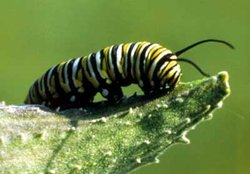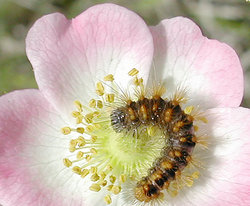Caterpillar
|
|
Caterpillar_at_5th_stage.jpg
A caterpillar is the larval form of a lepidopteran (a member of the insect order comprising butterflies and moths).
Caterpillars have long segmented bodies and many sets of "legs". They eat leaves voraciously, grow rapidly, shed their skins generally four or five times, and eventually pupate into an adult form.
Caterpillars have six true legs (being hexapods) on the thorax, up to four pairs of prolegs on the middle segments of the abdomen, and sometimes a single pair of prolegs on the last abdominal segment. The sawfly larva (Hymenoptera) superficially resembles a caterpillar, but can usually be distinguished because the caterpillar has a gap between true legs and prolegs, whereas the sawfly does not. Another difference is that lepidopteran caterpillars have crochets or hooks on the prolegs. The gap between the prolegs and the true legs can vary from a slight gap in some species to a large gap in families such as the geometridae. The geometrids, also known as inchworms or loopers, are so named because of the way they locomote, appearing to measure the earth (the word 'geometrid' means 'earth-measurer' in Greek).

Caterpillars do not breathe through their mouths. Air enters their bodies through a series of small tubules along the sides of their thorax and abdomen. These tubules are called 'spiracles', and inside the body they connect together into a network of airtubes or 'tracheae'.
Caterpillars do not have very good eyesight or senses. Rather than having fully-developed eyes they have a series of six tiny eyelets or 'ocelli' on the lower portion of their head. They rely on their antennae to help them locate food.
Many species of birds and animals consider caterpillars to be a tasty protein snack, so the caterpillars have evolved several methods of protecting and/or camouflaging themselves. These methods can be either passive, aggressive, or both. Some caterpillars have large 'false eyes' towards the rear of their abdomen. This is an attempt to convince predators that their back is actually their front, giving them an opportunity to escape to the 'rear' when attacked. Others have a body coloration that closely resembles their food plant.
More aggressive self-defence measures are taken by the spitfires and hairy caterpillars. These caterpillars have spiny bristles or long fine hairs that will irritate anything that brushes against them, or spit acidic digestive juices at potential enemies. However, some birds, like cuckoos, will swallow the hairiest of caterpillars.
A final grouping of caterpillars eat the leaves of plants that are toxic to other animals. They are unaffected by the poison themselves, but it builds up in their system, making them highly toxic to anything that eats one of them. These toxic species, such as the Cinnabar moth (Tyria jacobaeae) caterpillars, are brightly striped or coloured in red and yellow - the 'danger' colours.
The aim of all these aggressive defense measures is to assure that any predator that eats (or tries to eat) one of them will not be in a hurry to repeat the experience.
Some caterpillars obtain protection by associating themselves with ants. The Lycaenid butterflies are particularly well known. Recent findings have shown that they communicate with their ant protectors by means of vibrations as well as chemical means.
Some caterpillars are considered serious pests of agriculture or forestry. The include the Small White butterfly (brassicas), the Pine Butterfly, and the Codling Moth (apples).

